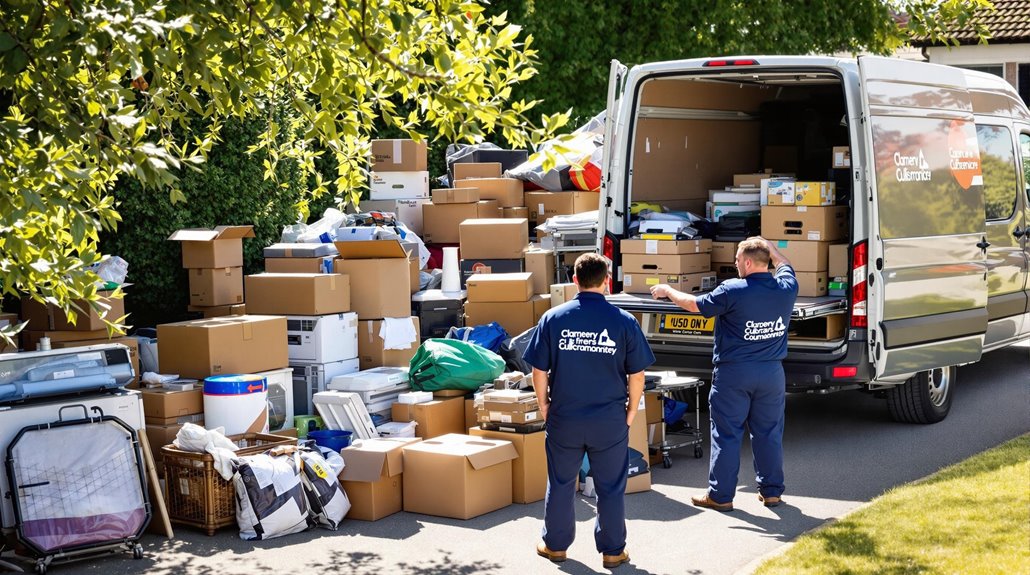I’ve discovered that most UK homeowners approach house clearance completely backwards—they pay companies £300-£1,500 to haul away items that could actually generate income instead. While you’re worrying about clearance costs, valuable antiques, electronics, and collectibles are sitting in your spare room, potentially worth 40-60% of their original retail price. There’s a systematic approach to identifying these profit opportunities that most people miss entirely, and it starts with understanding what clearance companies don’t want you to know.
Key Takeaways
- Identify valuable items like antiques and vintage electronics before clearance to maximize profit potential from your clutter.
- Sell antiques at auctions for 40-60% of retail value or use eBay for direct sales to avoid clearance fees.
- Choose clearance companies with auction partnerships that deduct saleable item values from your final clearance bill.
- Working appliances can yield 25-40% of new prices when sold locally rather than disposed of during clearance.
- Negotiate clear profit-sharing terms upfront and obtain professional appraisals to avoid underselling valuable items during house clearances.
Average UK House Clearance Costs

House clearance costs in the UK vary greatly based on the size and complexity of the job. I’ve found that you’ll typically pay between £175-£595 for most house clearances, though this can reach £1,000 for exceptionally large properties or complex situations.
For smaller clearances up to 500kg, you’re looking at £170-£200 to start. Most full house clearances fall into the £325-£595 range, depending on the volume of items and accessibility of your property.
The pricing structure generally works on a combination of weight and volume. Companies assess how much stuff you’ve got, how difficult it’ll be to remove, and whether they need special equipment or additional crew members. Regional variations can also impact your final quote, as local market rates influence the overall pricing structure across different areas of the UK. I’d recommend getting quotes from multiple providers since prices can vary greatly between different clearance companies in your area.
Key Factors Affecting Clearance Pricing
Understanding these baseline costs helps, but several specific factors will push your quote up or down from those averages.
Volume drives everything. I’ve seen quotes double when a job expands from one van load to three. Your property’s logistics matter enormously—if you’re on the fourth floor without a lift, expect higher rates. London jobs typically cost most, while Scottish clearances run cheapest. It’s also important to consider the legal steps involved in property clearance, especially if the items belong to a former tenant.
Waste type affects pricing considerably. Hazardous materials like paint trigger surcharges, while electronics need specialized recycling fees. White goods and bulky furniture bump costs up further.
Labour intensity escalates quickly. Heavy dismantling, tight staircases, or limited parking access all extend time requirements. Add-ons like cleaning services increase quotes by 15-25%, while same-day bookings include premium charges. Professional clearance companies should provide detailed quotes that break down all costs to help you budget effectively.
Clearance Costs by Property Type

Property size determines your clearance bill more than any other single factor. I’ve broken down typical costs by property type to help you budget effectively.
Single rooms cost £50-£150, perfect for bedsits or clearing one space. One-bedroom flats range £200-£400, covering your basic living essentials. Two-bedroom properties jump to £300-£600 as furniture volume doubles.
Three-bedroom houses hit £500-£1,000, where you’re dealing with family-sized clearances including multiple beds, wardrobes, and accumulated belongings. Four-bedroom houses and larger properties command £800-£3,000+, reflecting substantial furniture loads and potential specialty items. Professional companies ensure safe and legal disposal of all your unwanted items, taking the burden off your shoulders.
These ranges assume standard clearances. Your final cost depends on item weight, access difficulty, and whether you’re selling valuable pieces back to offset charges.
Cost Based on Volume and Van Size
Volume determines your van requirements and directly impacts your final bill. I’ve found that understanding this relationship helps you budget accurately for your clearance project.
Small vans holding 10-12 cubic yards cost £150-£200 per load, while large vans accommodating up to 25 cubic yards run £200-£300. Your property size dictates volume: single rooms need one small van, but four-bedroom houses often require multiple large van loads.
I always recommend choosing the largest van that’ll access your property. Multiple trips with smaller vans increase labour and fuel costs considerably. However, narrow roads or parking restrictions may force you into smaller vehicles.
Each additional van load adds £150-£300 to your total cost, plus extra disposal fees calculated per ton or load. Some companies will offset costs by deducting the value of any saleable items they collect from your final bill.
Time Investment for Clearance

Three factors determine how long your house clearance takes: property size, item complexity, and whether you hire professionals or tackle it yourself. I’ve seen homeowners spend weeks sorting through decades of belongings, but professional services complete the same job in 1-2 days. Here’s what matters: staged homes sell 17% faster, and every day on the market costs you money in carrying costs. Additionally, investing in energy-efficient improvements during your clearance can attract more buyers, enhancing your property’s appeal.
Professional clearance teams handle sorting, removal, and disposal logistics without your involvement. They’ll align their timeline with your sale or relocation schedule, saving you valuable weeks of labor. Clear spaces also allow potential buyers to envision their own belongings in the home, making it easier for them to see themselves living there and enhancing emotional connections. In competitive markets with high transaction volumes, quick property preparation becomes essential. Don’t let delayed clearance extend your days-on-market metrics—time saved through professional services often offsets costs through higher sale prices.
Avoiding Clearance Costs: The Profit Opportunity
Instead of paying clearance fees, you can transform your house clearance into a profit-generating exercise. I’ve seen homeowners avoid £150-£2,500 clearance costs while generating substantial returns through strategic selling.
Your antique furniture can yield 40-60% of retail value at auction, while vintage electronics fetch 20-50% of original prices online. Designer clothing retains 30-70% value on resale platforms. Working appliances sell locally for 25-40% of new prices. Choosing the right estate agent can also enhance your selling strategy by attracting more buyers.
You’ll maximize profits by selling directly on eBay, bypassing clearance fees entirely. Metal scrapping returns £50-£300 per tonne. Charity donations provide tax reductions up to 20%. Free collection services handle reusable goods.
Location matters – London sellers net 25% more than the national average, making your clearance location a profit factor. Consider that property size significantly impacts potential returns, as larger homes typically contain more valuable items to sell.
Steps to Turn Clutter Into Cash
Maximizing your house clearance profits requires a systematic approach that transforms scattered belongings into organized revenue streams. I’ll walk you through the essential steps that turn your clutter into cash.
First, I identify valuables before clearance begins. I separate antiques, jewelry, artwork, and vintage electronics, then document everything photographically. Professional appraisals guarantee I’m not underselling unique pieces, and it’s crucial to recognize that enhanced curb appeal can also contribute to overall property value.
Next, I secure written quotes from at least three clearance companies, providing detailed item lists like “1930s walnut dresser” for accurate valuations. I negotiate clauses ensuring payment when resale exceeds clearance costs. I prepare for scenarios where clearance costs exceed item values, as clients must cover the difference when disposal expenses outweigh potential earnings.
Finally, I optimize logistics by consolidating items, pre-sorting recyclables, and scheduling during off-peak hours. I demand transparent valuation metrics and retain rights to family heirlooms before signing any agreements.
Maximizing Your House Clearance Profit Potential
While most homeowners view house clearance as a necessary expense, I’ve discovered that strategic planning transforms this cost into a profitable venture. I always inventory items before clearance, identifying antiques, jewelry, and electronics that generate highest auction returns. You’ll maximize profits by requesting in-person valuations rather than phone estimates—this prevents undervaluation of collectibles and vintage furniture. Additionally, understanding the probate process can help streamline the sale of inherited items.
I negotiate contracts specifying profit-sharing terms upfront and avoid companies charging flat fees without itemized deductions. Document everything photographically for valuation disputes. Choose clearance firms with dedicated auction partnerships and recycling channels rather than landfill services.
Separate recyclables like metals and textiles to reduce disposal fees. Time your clearance strategically—post-inheritance allows proper antique identification. With proper preparation, your clearance company pays you instead of charging fees. Be aware that special items like fridges incur extra charges of £120, which can significantly impact your profit calculations.
Conclusion
I’ve shown you how house clearance doesn’t have to drain your wallet. You can flip the script by identifying valuable items, partnering with profit-sharing clearance firms, and timing your sale strategically. Don’t just pay for clearance—make it pay you. Start by cataloging your items, research their worth, and choose the right selling channels. Your clutter isn’t just taking up space; it’s sitting on potential profit waiting to be accessed.
References
- https://ecowasteclearance.co.uk/house-clearance-costs-in-london-2025/
- https://www.comparemymove.com/guides/house-clearance/house-clearance-costs
- https://www.clearaspace.co.uk/how-much-does-house-clearance-cost-in-the-uk-get-the-facts/
- https://www.myjobquote.co.uk/costs/house-clearance
- https://propertysaviour.co.uk/how-much-does-house-clearance-cost/
- https://www.checkatrade.com/blog/cost-guides/house-clearance-cost/
- https://www.mitchellsmovingcompany.com/blog/the-cost-of-house-clearance-what-to-expect
- https://rubbishman.co.uk/2025/01/31/full-house-clearance-costs-how-much-is-a-full-house-clearance-cost/
- https://www.nugenwaste.co.uk/house-clearance-costs
- https://clearitout.co.uk/how-does-house-clearance-work/

